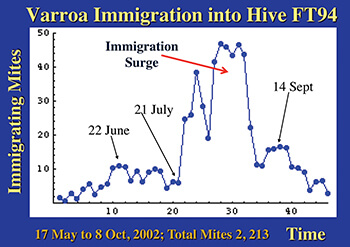
We’ve all heard of mite bombs and varroa hitchhiking into our colonies via robber bees. But how many are actually sneaking in? As the summer comes on in full force, be advised this is the time when varroa mite immigration can spike, in some years quite drastically.
Varroa mites can enter our hives in large numbers. I will show some of my scientific data on varroa mite immigration that I meticulously collected several years ago to demonstrate how varroa immigration can rapidly increase mite populations. However, before I delve into what I saw firsthand, let’s review two older, but still relevant, research papers. The typical setup to monitor mite immigration is to have colonies with virtually no varroa mites at the beginning of the observational period. This is usually achieved through a very effective miticide treatment. To make sure no varroa reproduction occurs in the colony, a continuous miticide treatment is then applied.
This continuous treatment is for research purposes only and should never be used to control varroa mites. Used on a routine basis, such a treatment could result in contaminated honey and wax. It is also detrimental to the bees and could lead to the development of resistant varroa mites.
Since initially the varroa population was essentially zero, mites found on the sticky board must have immigrated into those colonies. The sticky boards were replaced every few days during the active season. The incoming varroa were counted over the time period. When finished, one can see how the number of immigrating varroa fluctuated over the season. Summing up the varroa over time gives the total number of mites that would have reinfested the colony. The actual number would be much higher, because under normal circumstances those immigrating varroa would reproduce, thus roughly doubling the varroa population every reproductive cycle. But the continuous miticide application ensures that those immigrating mites were killed before they could reproduce.
Both research papers (and my own data, which I report below) show the same varroa immigration pattern. Varroa immigration is low in the spring when forage is abundant. Then varroa immigration can increase dramatically during the summer when forage is scarce.1,2 This low-nectar-flow and high-dearth varroa immigration pattern most likely results from robbing.
When forage is abundant, robbing is quite infrequent. When forage becomes scarce, bees will rob honey from weak colonies. As these colonies become weak from large varroa mite populations, regular colony functions (like guarding the hive entrance) diminish or break down, making it easy for strong colonies to steal honey. When robber bees plunder these colonies, free-roaming varroa mites latch on to them and ride back to their colonies. The varroa mites can actually smell when their host colony is crashing and will preferentially climb onto foragers.3-5
Those immigrating mites fuel the parasite population growth in the robbing


